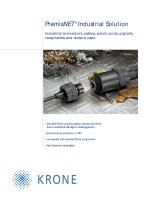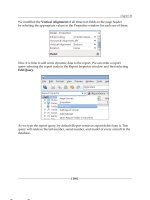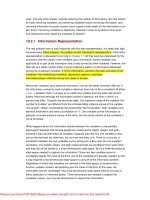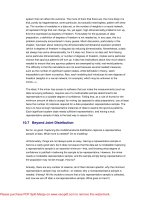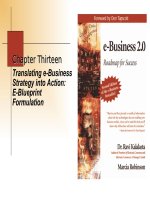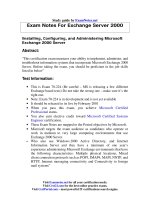Web-based IDE for Interfacing View Controller pptx
Bạn đang xem bản rút gọn của tài liệu. Xem và tải ngay bản đầy đủ của tài liệu tại đây (508.44 KB, 40 trang )
CS Web-based IDE for Interfacing
View Controller
Presenter: Tejasvi Palvai
CS 298
Advisor- Dr. Chris Pollett
Committee Members- Dr. Mark Stamp
Dr. Robert Chun
Outline
• Purpose
• Why Web-based IDE?
• Tools
• Features
• Performance issues
• Conclusion
• References
Purpose
• The main purpose of this project is to develop a web version of an
IDE i.e., Web-based IDE (Coding in the cloud) for Struts based
Projects.
• To interface view and controller components of MVC architecture.
• Enables users to create XHTML pages using the drag and drop
mechanism.
• Developed this using Struts framework.
Why Web-based IDE?
• An IDE is a software application that provides comprehensive
facilities like a source code editor, compiler for development.
Eg: Eclipse, Net Beans.
• IDEs are desktop-based applications. Users have to install and
configure these applications.
• Web-based IDEs has numerous advantages…….
Advantages of Web-based IDE
• Instant Development.
o Avoids environment setting or configuration.
• Accessing the Code from anywhere.
o All we need is Internet connection .
• Layout.
o Layout techniques of web applications guide users in certain focused
directions.
Existing Web-based IDE
• Bespin( Developed by Mozilla)
It is a web-based IDE (editor) that allows developers to collaborate
on code-based projects.
Disadvantages:
– At present it supports only JavaScript, HTML, CSS code
– Compatible only with Firefox browser.
– JavaScript errors with IE.
– The present version has sluggishness in the cursor movement.
Tools
• Struts Framework
o Open source framework based on MVC architecture.
• CKEditor
o Open source text editor
• Tomcat Server
o Used to host this Web-IDE.
• Firebug
o Helps in finding errors and debugging.
• Languages
o Java
MVC architecture
• Model-View-Controller is architectural pattern in Software
Engineering.
• Separates business logic and application data from presentation
data.
• Model
o It is both data and business logic to manipulate data.
• View
o Represents user view of application and takes inputs from user
• Controller
o Receives input and initiates a response by making calls on model objects
MVC ctd
Struts
• It is an open source framework based on Model-View-Controller
architecture.
• A Standard for developing well-architecture Web applications .
• Easy to integrate with client side technologies.
Directory structure for Struts based Projects
Action classes
• It is the developer's responsibility to create these classes.
• They act as bridges between user-invoked URIs and business
services.
• Actions process a request and return an ActionForward object that
identifies the next component to invoke.
• They are part of the Controller layer, not the Model layer.
Form files
• They act as a "firewall" between forms (Web pages) and the
application (actions).
• These components allow the validation of user input before
proceeding to an Action.
• In this project, these files are kept under
com.visualbuilder.struts.beans and are typically written using Java
beans.
Configuration files
• These files are mainly used for establishing the connection between web
application and web container.
Struts-Config.xml:
• It is the main configuration file.
• Its where all the struts Actions are defined and what JSP pages are used to
display them .
Web.xml:
• The web.xml file provides configuration and deployment information for
the web components that comprise a Web application.
<welcome-file-list>
<welcome-file>Welcome.html</welcome-file>
</welcome-file-list>
Preliminary Work
•Developed the basic struts application.
• Created a web application to get comfortable with Struts
•Compared different JavaScript frameworks(YUI, JQuery,DOJO)
• YUI,DOJO uses more memory when compared to JQuery and DOJO. YUI
took around 78k and JQuery used 65 k of memory .
• JQuery performs well in almost all the browsers and also has effective
and short code.
Layout for IDE
• Left part of IDE is for managing the projects.
• Top part is the horizontal menu bar. These are stacked next to each
other.
• The right most part of the IDE has HTML elements to create forms.
• The central part is the edit part. Its purpose is to write and read the
code.
UI of IDE
• Created the View part of the IDE
Login Page
• The project root can be accessed by using the url
url http://localhost:8080/strutswebproject/ .
• The above url will redirect to
http://localhost:8080/strutswebproject/WEB-INF/Welcome.html/
internally.
Features of IDE
• Project Creation.
• Horizontal Menu.
• Tabs for View.
• Tool bar.
Projects Creation
• When a user creates a new project,3 subfolders gets created in
server.
o Action
The Action folder has the Action. java , which is a controller file.
o Model
The Form folder has a Form. java file which is a Model file.
o Web-Inf
It has three different files, namely Index.jsp, Struts-config.xml and
web-xml files.
Implementation
• When a user creates a project,it stores in the server.
• One can get path of the server by
getServlet().getServletContext().getRealPath();.
• The folder is traversed and sent to the view through a string buffer.
Request.setAttribute("ProjectUserName",Buffer); method sends
buffer to client side.
• In client side values can be retrieved by using
<%StringBuffervalues=(StringBuffer)request.getAttribute ("
ProjectUserName "); %>
Implementation
• Once the buffer value is retrieved, for each project an ‘ul’ element is
created and for each file inside the folder, an ‘li’ element is created.
• The following is the code:
for(i=0, pa=0;i<arg.length && pa<patharg.length;i++,pa++)
{
var num =arg[i];
var newdiv = document.createElement('li');
newdiv.innerHTML = num;
newNext.appendChild(newdiv);
newdiv.setAttribute("id",patharg[pa]);
}
Reading and Writing to the Files
• When the user clicks on a file to read or write the code, an Ajax call is made
with the pathname .
• Th java file(ReadAction.java) reads the contents of the file from server and
returns the string buffer.
• When the user writes and saves the file, it gets stored.
• Following is the code:
$.ajax({'type' : 'POST',
'url' : 'Read.do',
data : 'project='+path_name,
success: function(msg)
{
msg = msg.replace(/\n/gi, "<br>");
$('#tab2 textarea#editor1').val(msg);
}
});
}
Tree structure of user created Projects
Horizontal Menu
• The Horizontal menu bar has menu items next to each other from
left to right and all other sub items are stacked vertically.
• Users can even create a new project here by clicking the ‘New
Project’ dropdown.
• When the user clicks on new project, a modal box opens and they
can enter the project name given in the place provided.
• A modal box is developed using JavaScript and is a technique for
developing dialog boxes without any popups.
